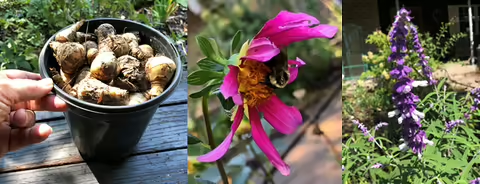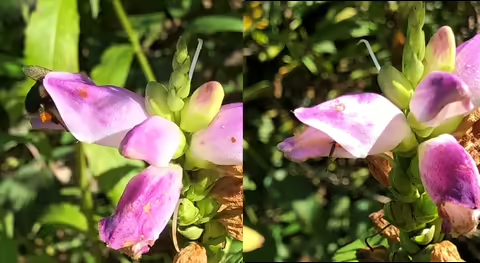It’s hard to believe that the first frost may be just around the corner, which means fall jungle cleanup is in operation. I usually prioritize what needs to be done first by what would be most affected by freezing temperatures. In my case, that’s plants. For my “tender” potted plants, I begin by gathering them up from around the jungle and getting them closer to their winter storage area…the garage. Just in case I get caught off guard, I like them close so they can be moved inside quickly. But until that point, I’ll use the time to trim, fertilize and hopefully spray a few times with insecticidal soap for mite, thrip, aphid and scale control before the need to move indoors. For “tender” bulbs, corms and rhizomes still in the ground, I just make a list of what needs to be dug so I don’t miss anything, and pay close attention to the weather forecast…meaning I leave them in the ground until the last minute. I usually overwinter elephant ears, dahlias, turmeric, ginger, tuberose and cannas. I prefer a light frost on the foliage to knock it back a bit before digging, though not required if a hard freeze is looming. Once dug, I remove all dirt from the roots and cut tops backs to 1-2” above the storage structure. Experts recommend letting the storage structures dry a few days before overwintering in a dark cool location surrounded by something loose and slightly moist like peat moss to avoid drying out during overwintering. I on the other hand am a bit passive aggressive with all the plants I dig…can’t bring myself to outright let them freeze, or throw them on the compost heap, but at the same time don’t go out of my way to ensure 100% survival. Contrarily, I continue to have good success just laying them out loosely in trays or paper bags, exposed to daylight...go figure?
I love the mysteries of gardening…like how five ‘Accent’ daffodil bulbs could multiply to over 50 sizable bulbs in a five year period. Imagine my impressed surprise when I decided to move said bulbs so I could plant something else in their place. It was like they were multiplying as I was digging. Next time I read “prolific” in the cultivar description, I’ll know to just buy the minimum, one if possible. Speaking of multiplying, I have dahlias…with the emphasis on the plural…blooming in my front yard without me having ever planted any in that location. And they look nothing like any that I have planted in the past. I’m beginning to think my passive aggressive approach is somehow working against me. Now I feel compelled to dig these volunteer plants as well; having already mentioned it is just not in me to outright kill a tender perennial by leaving it out in the cold. And who could edit out a dahlia anyway? Of course, I’m sure they’ll all survive my overwintering abuse and be beautiful in a place selected by me next year. And just to heighten the mystery a bit more, while I was standing in amazement over the Dahlias, I looked to my left and saw a volunteer Mexican sage…another beautiful tender perennial of unknown origin! Even odder, all of these horticultural amazements occurred within ten feet of each other.
I described fall-blooming pink turtlehead (Chelone obliqua) in a post last year as upright, usually unbranched and growing to roughly 3 feet tall. I also mentioned it’s easy to understand the common “turtlehead” name once you look at the flowers with a bit of fanciful imagination. Each inflated, tubular flower is irregular in shape, with the two upper petals fused into a hood-like structure (imagine a skull and upper beak) and the other 3 petals forming a bearded, 3-lobed lower lip (imagine the tongue and lower beak). Bumblebees though, fear it not. I recently stood transfixed watching bumblebees squeeze their way into turtlehead flowers, at times completely disappearing into their depths. Ingenious how flowers have evolved to ensure certain pollinators make contact with reproductive surfaces before offering up a reward.


